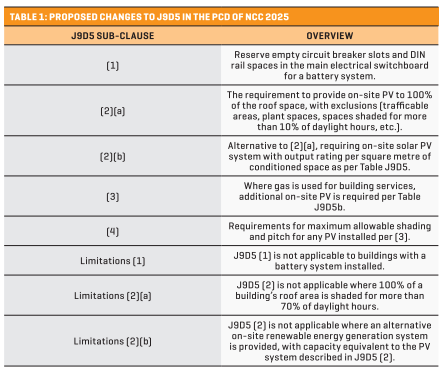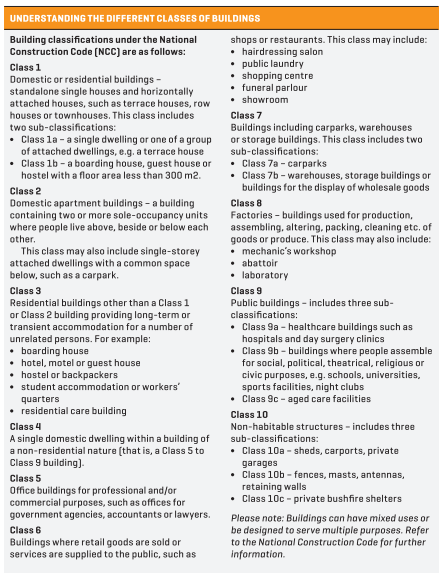Come and see (what might be in) the new NCC
We’re one step closer to a new National Construction Code. Sean Carroll looks at what might be coming in the NCC 2025, some thoughts from key industry bodies and what could change.
The National Construction Code (NCC), created by the Australian Building Codes Board (ABCB), is a performance-based code, containing all performance requirements for the construction of new buildings. It’s refreshed every three years to keep the industry up to date with emerging technologies and government mandates.
ADVERTISEMENT
The Australian Government’s Net Zero Plan aims to achieve net zero greenhouse gas emissions by 2050 and 43% below 2005 greenhouse gas emissions by 2030, following the Paris Agreement in 2016. The NCC includes several changes that aim to reduce emissions, support a net-zero future and transition away from fossil fuels.
One of the fastest ways to achieve this is through the building and construction industry. Data from the Department of Climate Change, Energy, the Environment and Water (DCCEEW) shows that buildings account for around 19% of total energy use and 18% of direct carbon emissions in Australia.
The NCC 2025, which has just passed the public comment draft (PCD) phase, includes several proposed changes to further electrify buildings, encourage the use of electric vehicles (EVs) and the mandatory installation, maintenance and upgrading of solar solutions. The main changes in the NCC 2025 that impact the work of electricians are:
- Mandated EV charging infrastructure
- Solar mandates that support a transition towards a renewable electricity grid
- Electrification of buildings including the electrification of various utilities
- Stricter thermal performance requirements and mandatory on-site generation for commercial buildings
Electricians and building practitioners were encouraged to comment on any changes to the draft NCC 2025 by 1 July 2024. The ABCB and its technical committees will now review the comments in the coming months before releasing a follow-up draft.
Revving up your (electric) engines
The ABCB is proposing changes that give all new buildings effective ways to support the ongoing uptake of EVs. It does this by mandating that EV charging infrastructure is installed in new builds but also by putting efficiencies in place for the event of a fire.
All Class 1 buildings must provide EV charging circuits and pre-provisioning equipment for one car parking space. Class 2 buildings (apartments) must provide EV charging circuits and equipment sufficient for all car parking spaces and a provision for future battery installations.
For buildings defined as Class 3 and Classes 5-9, EV charging equipment must be sufficient for the daily driving of 20% of occupants.
The Electric Vehicle Council (EVC) responded to the changes in its public comments on the NCC 2025 draft, writing: “We are pleased to see requirements for an EV circuit written in for Class 1 buildings. Provision of a cable from the main switchboard to the car parking space(s), with at least one circuit capable of carrying 32A, will ensure the future installation of EV charging equipment will be quick and cost less.
“This is a minimum standard, and customers could have a three-phase circuit run instead, should they want. Running cables in modern houses is much easier, cheaper and potentially more aesthetically pleasing when done at the frame stage.”
NECA director for technical policy and safety Neil Roberts says he disagrees with the mandate to install a 32A charger in all new builds in favour of more flexibility: “They [ABCB] basically suggested that you must put a 32A circuit in, put a 15A general purpose outlet (GPO) at the end of it and then nominate a cable size. Most electricians will tell you that the cable size will depend on how long the run is and the conditions on which it’s run.”
Neil believes that the NCC would be better making a general recommendation to builders that they must provide an EV charging point, even if it’s a Type 2 EV charger. From there, the electricians who come in could install an appropriate charging solution based on the end user’s needs.
The EVC didn’t make any changes to these recommendations, adding that the requirement to terminate a cable with at least a 15A GPO will see the majority of Australians served with enough energy to power their daily driving needs.
“We note that by using the ‘limitation’ method of determining maximum EV charging demand, there is no need to increase the consumer mains capacity to accommodate EV charging,” the EVC writes.
In a June 2023 advisory notice from the ABCB, the board noted that: “EVs have a lower likelihood of being involved in a fire than internal combustion engines, but the characteristics of battery fires are different to liquid fuel fires.”
As a result, the NCC 2025 has included several changes to modernise the NCC to improve the fire safety of car parks and occupants located in, and adjacent to, all new buildings.
Outside of physical changes to car parks (like expanding alternatives to include fire-protected steel alongside fire-protected timber as an accepted form of construction in Classes 2,3 and 5-9 buildings), the NCC 2025 will remove EVs and EV charging equipment from the “special hazards” in Clause E1D17 and E2D21 of the NCC 2022.
“The EVC was pleased to see clarification from ABCB chief executive officer Gary Rake on the intended interpretation of special hazard in the NCC, which is that the presence of EVs and EV charging equipment is now common, should not be considered special and therefore, is not sufficient to invite the ‘special hazard’ clauses.”
The EVC notes that while the provision of these clauses doesn’t impact regulation, it takes steps towards removing the stigma from EV-related solutions as fire-prone.
The sun keeps on shining
Proposed changes to NCC 2025 include deemed-to-satisfy (DTS) provisions that seek to maximise the generation and use of solar photovoltaic (PV) energy on-site.
The provisions maximise the amount of PV panels on suitable roof space of Class 3 to 9 buildings and common areas of Class 2 buildings. The provisions include capacity limits that aim to ensure most of the generated energy is used on-site, where it will provide the greatest benefit and minimise the building’s impact on the grid.
Part J9D5 of the NCC 2022 required new buildings to add provisions for future on-site solar and batteries. The section includes adding labelled spare compartments in the electrical switchboard for protection and metering (Part J9D5 (1)) as well as, where possible, allowing for usable rooftop space for future PV installation in accordance with Part J9D5 (2).
Table 1: Proposed changes to J9D5 in the PCD of NCC 2025
| J9D5 sub-clause | Overview |
| (1) | Reserve empty circuit breaker slots and DIN rail spaces in the main electrical switchboard for a battery system. |
| (2)(a) | The requirement to provide on-site PV to 100% of the roof space, with exclusions (trafficable areas, plant spaces, spaces shaded for more than 10% of daylight hours, etc.). |
| (2)(b) | Alternative to (2)(a), requiring on-site solar PV system with output rating per square metre of conditioned space as per Table J9D5. |
| (3) | Where gas is used for building services, additional on-site PV is required per Table J9D5b. |
| (4) | Requirements for maximum allowable shading and pitch for any PV installed per (3). |
| Limitations (1) | J9D5 (1) is not applicable to buildings with a battery system installed. |
| Limitations (2)(a) | J9D5 (2) is not applicable where 100% of a building’s roof area is shaded for more than 70% of daylight hours. |
| Limitations (2)(b) | J9D5 (2) is not applicable where an alternative on-site renewable energy generation system is provided, with capacity equivalent to the PV system described in J9D5 (2). |
Previous versions of the NCC didn’t have any DTS provisions that required solar to be specified. Under the proposed changes, designers following the DTS pathway to show compliance will need to undertake a review of the site and building design during the design phase to evaluate where solar should be installed.
Which way is the exit?
One of the proposed changes in the PCD is around hybrid photoluminescent exit signs. These exit signs aren’t powered like traditional exit signs but use photoluminescent technology that absorbs ultraviolet (UV) light during the day and holds the glow throughout a period of darkness.
Since 2014, the NCC DTS provisions have permitted photoluminescent exit signs as an alternative to conventional illuminated exit signs. At the time, passive photoluminescent exit signs were common and required charging from an external light source.
Since 2014, the technology in these exit signs has been developed and modern models now include an internal light source that provides charge during all hours.
The proposed change in the PSD is to include referencing Standards Australia Technical Specification (SA TS) 5367:2021 Photoluminescent exit signage – Hybrid photoluminescent signage – Product specification, installation and operation in E4D8(ii) and (iii). These changes will accommodate hybrid photoluminescent exit signs and facilitate their adoption through the DTS pathway, making it easier to comply with the NCC.
Next steps
The public comment phase for the NCC 2025 closed on 1 July 2025 and at the time of writing, the ABCB is now in the consultation phase. After receiving public comments, the Board makes any adjustments or changes before it is approved and an official adoption date for the NCC is set.
Before adoption, the ABCB publishes a preview of the new edition to help building and construction professionals familiarise themselves with the changes.
BOX-OUT:
Understanding the different classes of buildings
Building classifications under the National Construction Code (NCC) are as follows:
Class 1
Domestic or residential buildings – standalone single houses and horizontally attached houses, such as terrace houses, row houses or townhouses. This class includes two sub-classifications:
- Class 1a – a single dwelling or one of a group of attached dwellings, e.g. a terrace house
- Class 1b – a boarding house, guest house or hostel with a floor area less than 300 m2.
Class 2
Domestic apartment buildings – a building containing two or more sole-occupancy units where people live above, beside or below each other.
This class may also include single-storey attached dwellings with a common space below, such as a carpark.
Class 3
Residential buildings other than a Class 1 or Class 2 building providing long-term or transient accommodation for a number of unrelated persons. For example:
- boarding house
- hotel, motel or guest house
- hostel or backpackers
- student accommodation or workers’ quarters
- residential care building
Class 4
A single domestic dwelling within a building of a non-residential nature (that is, a Class 5 to Class 9 building).
Class 5
Office buildings for professional and/or commercial purposes, such as offices for government agencies, accountants or lawyers.
Class 6
Buildings where retail goods are sold or services are supplied to the public, such as shops or restaurants. This class may include:
- hairdressing salon
- public laundry
- shopping centre
- funeral parlour
- showroom
Class 7
Buildings including carparks, warehouses or storage buildings. This class includes two sub-classifications:
- Class 7a – carparks
- Class 7b – warehouses, storage buildings or buildings for the display of wholesale goods
Class 8
Factories – buildings used for production, assembling, altering, packing, cleaning etc. of goods or produce. This class may also include:
- mechanic’s workshop
- abattoir
- laboratory
Class 9
Public buildings – includes three sub-classifications:
- Class 9a – healthcare buildings such as hospitals and day surgery clinics
- Class 9b – buildings where people assemble for social, political, theatrical, religious or civic purposes, e.g. schools, universities, sports facilities, night clubs
- Class 9c – aged care facilities
Class 10
Non-habitable structures – includes three sub-classifications:
- Class 10a – sheds, carports, private garages
- Class 10b – fences, masts, antennas, retaining walls
- Class 10c – private bushfire shelters
Please note: Buildings can have mixed uses or be designed to serve multiple purposes. Refer to the National Construction Code for further information.
-
ADVERTISEMENT
-
ADVERTISEMENT




